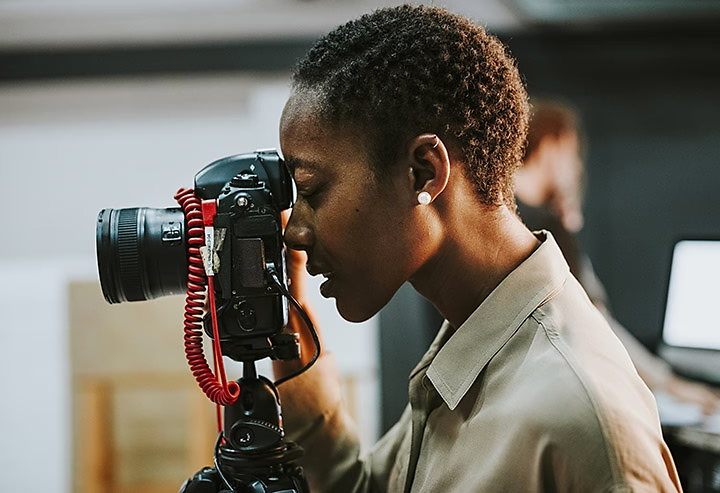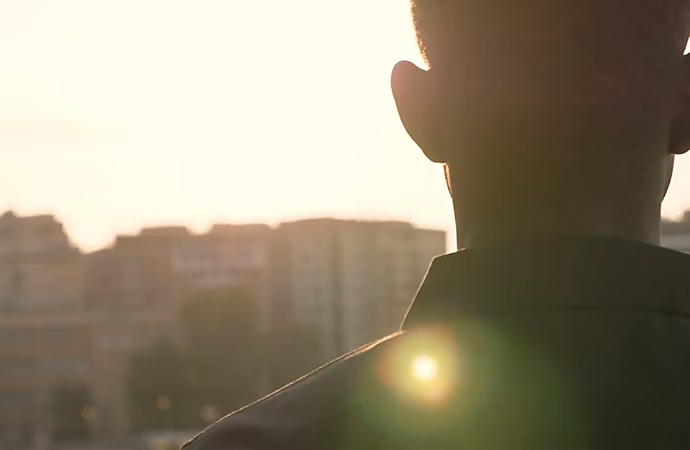Combinar historias con material de archivo adicional
- El material de archivo adicional son las secuencias que complementan tus clips de video principales.
- Sirve para establecer una escena, suavizar una transición o aportar significado.
- Elabora una lista de tomas para asegurarte de escoger el material de archivo adicional adecuado para contar tu historia.
¿Qué es el material de archivo adicional?
El material de archivo adicional recibe también el nombre de B-roll (rollo o cinta B), término que se originó en los comienzos de la industria cinematográfica, cuando los equipos de edición insertaban material adicional, o B-roll, en el principal, o A-roll (rollo o cinta A), para ocultar las rayas que se apreciaban en las uniones de dos trozos de película. En la producción de video y cine moderna, el material de archivo adicional se refiere a todas las grabaciones que no forman parte de la acción principal.
es decir, todas las secuencias en las que no aparezcan los personajes principales interactuando entre sí o hablando a cámara. Dicho material adicional puede proceder de filmaciones o fotografías de archivo, así como de equipos secundarios cuyo trabajo consiste en captar material adicional.
Aunque con el video digital se eliminó el problema del empalme de las películas, los realizadores de videos con y sin guion siguen empleando el material de archivo adicional para definir las escenas, suavizar las transiciones y eliminar momentos o fotogramas no deseados sin tener que desechar toda la toma. “Aunque suene como algo secundario, el material de archivo adicional es lo que crea los matices de la narración visual”, afirma el director y cinematógrafo Hiroshi Hara.
Material de archivo adicional en videos guionizados
El material de archivo adicional es imprescindible en los largometrajes de ficción para transmitir la sensación de espacio y tiempo, así como para dotar de significado a la historia. Los planos de contexto, que aparecen al principio de las escenas y muestran las calles de una ciudad o el exterior de un edificio, suelen ser material de archivo adicional, así como otros planos que se alejan de la acción principal.
Por ejemplo, si dos personajes se encuentran en la esquina de una calle y uno le dice al otro: “Ese es el banco que quiero robar”, la película puede cambiar a un plano del edificio del banco, sobre el que el otro personaje puede responder “Es imposible” en voz superpuesta. Este tipo de material también ofrece al editor más opciones a la hora de unir varias tomas de una escena.

Material de archivo adicional en videos documentales
El material de archivo adicional es indispensable para las noticias y los documentales. Cualquier formato que contenga muchas secuencias de entrevistas puede beneficiarse de un metraje alternativo relevante y visualmente interesante.
“Una entrevista con una persona quieta que simplemente habla a cámara puede resultar bastante aburrida. Pero, con el material de archivo adicional, se puede mejorar la experiencia de narración. También se puede emplear cuando hay que cortar entre determinadas frases o reducir el tiempo sin que se produzca un corte de salto”, comenta Hara. (Los cortes de salto son ediciones que saltan hacia adelante o hacia atrás en la misma toma, lo que a menudo produce un efecto discordante y desorientador).
Grabación de material de archivo adicional
Durante la fase de preproducción, ten en cuenta estos consejos para grabar la mayor cantidad de material adicional posible. En la posproducción te alegrarás de haberlo hecho.
Elabora una lista de tomas
En lo que respecta al material de archivo adicional, al igual que con el principal, ahorrarás tiempo, dinero y estrés si haces una lista de tomas. Piensa en la hora del día y en la estación del año en la que las grabarás, así como en el equipo que necesitarás. “Indica de manera concreta lo que quieres conseguir. Con la lista, será mucho más fácil visualizar los problemas o las limitaciones que pueden surgir”, explica Hara.

Cuenta una historia
Aunque tus personajes principales no aparezcan en estas tomas, puedes narrar una historia. “Ten en cuenta la luz, la composición y los sujetos. Con cada toma y, en concreto, con el material de archivo adicional, pregúntate si la imagen está contando una historia: ¿hay algún elemento en el fondo o en primer plano, en el lugar donde se encuentra el sujeto o con lo que este interactúa, que pueda hacer que la toma pase de ser simple y linda a estar llena de significado?”, recomienda el director Mike Leonard. Por ejemplo, puedes incluir afiches o monumentos que informen al espectador de dónde se sitúa la acción.


Para el carro
No te tomes la molestia de preparar una toma a la perfección para después perder la paciencia rápidamente y antes de hacer grabado suficiente material. “Tanto si se trata de un plano fijo como si hay movimiento de cámara, cuenta siempre hasta diez”, aconseja Leonard. La toma tiene que ser lo suficientemente larga como para poder cortarla y adaptarla al ritmo del diálogo. “El error de principiante más común es grabar una toma preciosa, con un lindo tema y una gran composición, pero demasiado corta”, comenta Leonard.
Experimenta con diferentes planos
Aunque el material de archivo adicional pueda ser menos interesante que el principal, ofrece cierto margen de maniobra. “Te obliga a ser creativo. Luego de grabar lo mismo una y otra vez, te das cuenta de que puedes hacerlo desde un ángulo de cámara inusual, emplear un lapso de tiempo o abordarlo desde una perspectiva única, como con un dron o un plano subjetivo”, afirma Leonard.
Sacar el máximo partido a la grabación
Cuanto tengas todo el material sin procesar necesario, practica cortándolo para formar tu historia. Las herramientas de edición como Adobe Premiere Pro facilitan la fusión del material de archivo adicional con el material principal a fin de obtener una historia uniforme. Cuando estés conforme con la edición, prueba a graduar el colorde las imágenes para conseguir los tonos adecuados.
Si necesitas inspiración, vuelve a ver tus películas favoritas y presta especial atención al material de archivo adicional. Si te gusta alguna toma, anótala y pregúntate qué es lo que te gusta de ella. Intenta aplicar todo lo aprendido a tu próximo proyecto y recuerda que la práctica hace al maestro.

